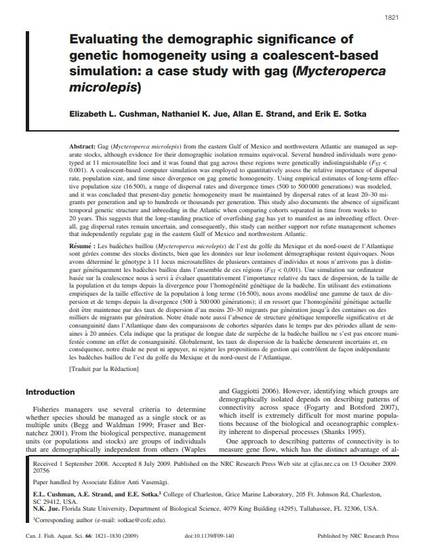
Article
Evaluating the demographic significance of genetic homogeneity using a coalescent-based simulation: a case study with gag (Mycteroperca microlepis)
Canadian Journal of Fisheries and Aquatic Sciences
(2009)
Abstract
Gag (Mycteroperca microlepis) from the eastern Gulf of Mexico and northwestern Atlantic are managed as separate stocks, although evidence for their demographic isolation remains equivocal. Several hundred individuals were genotyped at 11 microsatellite loci and it was found that gag across these regions were genetically indistinguishable (FST < 0.001). A coalescent-based computer simulation was employed to quantitatively assess the relative importance of dispersal rate, population size, and time since divergence on gag genetic homogeneity. Using empirical estimates of long-term effective population size (16 500), a range of dispersal rates and divergence times (500 to 500 000 generations) was modeled, and it was concluded that present-day genetic homogeneity must be maintained by dispersal rates of at least 20–30 migrants per generation and up to hundreds or thousands per generation. This study also documents the absence of significant temporal genetic structure and inbreeding in the Atlantic when comparing cohorts separated in time from weeks to 20 years. This suggests that the long-standing practice of overfishing gag has yet to manifest as an inbreeding effect. Overall, gag dispersal rates remain uncertain, and consequently, this study can neither support nor refute management schemes that independently regulate gag in the eastern Gulf of Mexico and northwestern Atlantic
Disciplines
Publication Date
2009
DOI
10.1139/F09-140
Citation Information
Elizabeth L. Cushman, Nathaniel K. Jue, Allan E. Strand and Erik E. Sotka. "Evaluating the demographic significance of genetic homogeneity using a coalescent-based simulation: a case study with gag (Mycteroperca microlepis)" Canadian Journal of Fisheries and Aquatic Sciences Vol. 66 Iss. 10 (2009) p. 1821 - 1830 Available at: http://works.bepress.com/jue-nathaniel/13/
